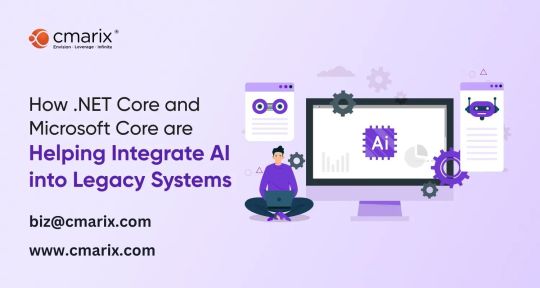#legacy systems
Explore tagged Tumblr posts
Text
Hackers Access Legacy Systems in Oxford City Council Cyberattack

Summary: Hackers breached Oxford City Council's legacy systems, potentially accessing personal data of staff involved in elections between 2001 and 2022. While there is no evidence of large-scale data exfiltration, the incident highlights the risks posed by outdated infrastructure and insufficient segmentation of historical data.
Source: https://www.securityweek.com/hackers-access-legacy-systems-in-oxford-city-council-cyberattack/
More info: https://www.oxford.gov.uk/news/article/1704/statement-on-cyber-security-incident
2 notes
·
View notes
Text
Mainframe Modernization services with vrnexgen
VRNexgen offers end-to-end mainframe modernization services, transforming legacy systems into agile, secure, and cloud-ready platforms. With expertise in z/OS, DevOps, APIs, and AI, we help enterprises improve performance, reduce costs, and future-proof their IT infrastructure.
#mainframe modernization#vrnexgen#legacy systems#mainframe modernization services#legacy system modernization#application modernization services#application modernization
0 notes
Text

Legacy systems often power the backbone of enterprise operations, yet their outdated nature poses growing challenges in an age of digital transformation. This blog explores the dual role of legacy infrastructure—its critical function and the risks it brings, including high maintenance costs, security vulnerabilities, and scalability limitations. Learn how businesses can uate legacy system relevance, mitigate risks, and implement strategies such as system decommissioning, data archiving, and migration to modern platforms. With AvenData’s expertise, organizations can turn legacy burden into a launchpad for innovation, compliance, and long-term growth without disrupting essential business functions.
#legacy software systems#legacy system#Legacy Systems#legacy system migration#legacy system migration strategy#legacy software
0 notes
Text
Unleashing Business Potential with SQL Server Standard 2014
Unlocking Business Success with the Timeless Power of SQL Server Standard 2014
In today's fast-paced digital landscape, choosing the right database platform is crucial for maintaining a competitive edge. Microsoft SQL Server Standard 2014 stands out as a reliable, robust, and versatile solution that continues to deliver exceptional value for businesses worldwide. Its enduring capabilities ensure seamless data management, optimized performance, and scalability, making it an ideal choice for organizations aiming to grow and innovate.
One of the key strengths of SQL Server 2014 is its stability and maturity. As a proven platform, it offers a dependable foundation for critical business applications, ensuring data integrity and security. Whether you're managing customer information, financial data, or operational metrics, SQL Server 2014 provides the tools necessary to handle workloads efficiently and securely.
Moreover, SQL Server 2014 introduces significant enhancements in in-memory technology, enabling faster transaction processing and real-time analytics. This feature allows businesses to accelerate decision-making processes and respond swiftly to market changes. The in-memory OLTP engine reduces latency and boosts throughput, ensuring that your enterprise applications run smoothly and efficiently.
For organizations with legacy systems, SQL Server 2014 offers excellent compatibility and integration options. Its support for various data formats and interfaces makes it easier to migrate and upgrade existing infrastructure without disrupting ongoing operations. This backward compatibility ensures that investments made in previous systems are protected, while still leveraging the latest advancements.
Data management is at the core of SQL Server 2014's value proposition. It provides comprehensive tools for data backup, recovery, and maintenance, safeguarding your information assets. Additionally, features like AlwaysOn availability groups enhance disaster recovery capabilities, minimizing downtime and ensuring business continuity.
Businesses looking to implement scalable solutions will appreciate SQL Server 2014's capacity to handle increasing workloads. Its architecture supports both small and large-scale deployments, making it adaptable to various organizational sizes and needs. With its user-friendly management interface and extensive support community, IT teams can optimize deployment and troubleshooting processes with confidence.
In terms of business applications, SQL Server Standard 2014 seamlessly integrates with other Microsoft products, creating a cohesive ecosystem that enhances productivity. Whether it's powering data-driven websites, enterprise resource planning systems, or customer relationship management tools, SQL Server provides the backbone for your enterprise infrastructure.
Investing in SQL Server Standard 2014 is not just about maintaining current operations—it's about future-proofing your business. Its enduring value lies in its ability to adapt, scale, and deliver consistent performance over time. As technology evolves, SQL Server 2014 remains a dependable partner in your journey toward innovation and growth.
Discover more about how SQL Server Standard 2014 can transform your data management strategies by visiting Dependable and Powerful: The Enduring Value of SQL Server Standard 2014 for Your Business. Embrace a solution that combines reliability, power, and flexibility to support your business ambitions now and into the future.
#SQL Server 2014#Reliable Database#Legacy Systems#In-Memory Performance#Data Management#Business Applications#Microsoft SQL
0 notes
Text
Is your legacy healthcare system holding you back? Discover how modernization can improve efficiency, data security, and patient outcomes in our complete guide.
0 notes
Text
KMH Integration Looks Ahead: Embracing New Tech, Talent, and the Future of Systems Integration
New Post has been published on https://thedigitalinsider.com/kmh-integration-looks-ahead-embracing-new-tech-talent-and-the-future-of-systems-integration/
KMH Integration Looks Ahead: Embracing New Tech, Talent, and the Future of Systems Integration
As media and broadcast workflows evolve, so too must the companies supporting them. KMH Integration, now celebrating 20 years in business, is preparing for the next era of AV systems design with a clear focus on new technology adoption and talent development.
President Kevin Henneman says the path forward lies in adapting to IP- and cloud-based systems while growing a workforce ready for that shift.
“Technology doesn’t stand still. We’ve made ongoing training a top priority so our team understands how emerging software-driven solutions complement or replace legacy systems.”
KMH is already supporting clients through hybrid workflows that blend traditional baseband setups with IP video, cloud-based production tools, and software-defined infrastructure. This approach ensures scalability, long-term ROI, and future-ready design for stadiums, studios, and enterprise clients alike.
Growing Talent to Match Changing Technology One of the biggest challenges the industry faces, according to Henneman, is building the next generation of technical professionals.
“We’ve partnered with local universities and found smart, passionate people who just needed exposure to the systems integration world. Some of our top team members came from those programs, and now they’re mentoring the next wave.”
KMH’s approach fosters a culture where every team member learns across disciplines — from cabling and installation to systems design and client consulting — creating a dynamic and well-rounded workforce.
Planning Projects for Maximum Flexibility As the pace of technology change accelerates, KMH is also rethinking project timelines and purchasing strategies.
“We encourage clients to reverse-engineer the project timeline,” Henneman says. “You don’t want to buy gear too early and miss the next big upgrade. With good communication, we can plan for the right moment.”
Whether designing modern control rooms or integrating broadcast-grade infrastructure in corporate or education environments, KMH remains committed to providing flexible, scalable, and intelligent systems tailored to each customer’s goals.
Read the full article here
#adoption#approach#Article#Building#Business#change#Cloud#communication#Companies#consulting#Design#development#EARLY#education#Engineer#enterprise#era#focus#Full#Future#Gear#how#hybrid#Industry#Infrastructure#integration#IP#Legacy systems#media#members
0 notes
Text
Top-grade Legacy App Modernisation Development Companies
Check out our leading legacy App Modernisation Development Companies. Deliver is famous for its deep technical skills, industry-based approach, and Confirmed strategies. Uncover what distinguishes these leaders, the criteria for evaluation, and how they enable enterprises to transition from outdated systems to Expandable digital infrastructures. Your legacy systems aren’t just old, they’re carrying your business back. In today’s digital-first world, outdated legacy applications are delaying down industries like finance, healthcare, and manufacturing. These systems often lack the agility, Extensibility, and safety needed to stay competitive. According to MarketsandMarkets, the global application upgrading market is expected to reach $39.62 billion by 2029, highlighting a sharp rise in demand for legacy application modernisation services. For more details, you can check out this blog.
0 notes
Text
Seamless Data Migration for Digital Transformation – Pilog Group’s Proven Expertise
As businesses evolve and adopt new technologies, migrating data from legacy systems to modern platforms becomes essential. However, data migration is not just about moving information—it’s about transferring clean, accurate, and meaningful data that supports business continuity and innovation. Pilog Group stands at the forefront of this process, offering reliable, efficient, and secure data migration solutions.
Understanding Data Migration
Data migration is the process of transferring data between storage types, formats, or computer systems. It often takes place during system upgrades, cloud adoption, or mergers and acquisitions. Poorly managed data migration can lead to data loss, downtime, and operational disruptions. That’s why a trusted partner like Pilog Group is crucial for ensuring a successful transition.
Why Choose Pilog Group for Data Migration?
With decades of experience in Master Data Management and digital transformation projects, Pilog Group offers end-to-end data migration services tailored to industry-specific needs. Their approach ensures not only the smooth transfer of data but also its quality, consistency, and compliance.
Core Benefits of Pilog’s Data Migration Services:
Data Accuracy: Pilog cleanses, deduplicates, and enriches data before migration to eliminate errors and redundancy.
Minimal Downtime: Well-planned execution ensures minimal impact on business operations.
System Compatibility: Migration services are compatible with major ERP platforms like SAP, Oracle, and Microsoft.
Secure Transfers: Pilog ensures data integrity and confidentiality throughout the migration process.
Post-Migration Support: Continued validation and testing after migration guarantee long-term reliability.
Pilog’s Proven Methodology
Pilog Group uses a structured, phase-wise methodology that includes:
Assessment and Planning
Data Cleansing and Mapping
Validation and Testing
Execution and Go-Live Support
Post-Migration Optimization
This approach ensures that data remains an asset, not a liability, after migration.
Conclusion
Data migration is a critical step in any digital transformation journey. With Pilog Group’s advanced tools, proven frameworks, and industry expertise, organizations can migrate their data with confidence and precision. Trust Pilog to turn a complex challenge into a strategic opportunity—ensuring your data is not just moved, but optimized for the future.
0 notes
Text
Reassessing Legacy Systems: Challenge or Catalyst for Modern Business?
Legacy systems often serve as the backbone of enterprise operations—but they come with hidden costs. This blog delves into the complex role these outdated technologies play in today's digital era, weighing their benefits against the barriers they pose to innovation. Learn how organizations can strategically assess, manage, and modernize legacy infrastructure through methods like system decommissioning and data archiving. Ideal for IT leaders looking to balance operational stability with transformation, this guide offers insights into turning legacy systems from obstacles into opportunities for growth.
#legacy software systems#legacy system#Legacy Systems#legacy system migration#legacy system migration strategy#legacy software
0 notes
Text
Why You Should Get Yourself a Job with Legacy Programming Languages
Key Takeaways “Old” languages are still relevant: FORTRAN, COBOL, and Pascal continue to play crucial roles in specific domains. FORTRAN: Excels in scientific computing and high-performance computing. COBOL: Remains essential in financial systems for handling large datasets and transactions. Pascal: Influenced modern languages and continues to be used in education. Career opportunities…
#career#COBOL#computer science#computers#dailyprompt#education#finance#FORTRAN#hacking#history#jobs#legacy systems#Pascal#Programming#scientific computing#technology
0 notes
Text
Supporting Robotics and Automation Rollouts with Industrial Estimating Services
Introduction Robotics and automation are revolutionizing industrial operations by boosting productivity, improving quality, and reducing labor costs. However, implementing these technologies requires significant investment and meticulous cost planning. Industrial estimating services play a pivotal role in supporting robotics and automation rollouts by providing detailed, accurate, and realistic cost estimates. These estimates help stakeholders make informed decisions and avoid budget overruns in complex automation projects.
Understanding the Cost Components of Robotics and Automation Robotics and automation projects involve a variety of cost elements beyond just the purchase price of equipment. Key components include:
Hardware costs: Robots, conveyors, sensors, controllers, and peripheral equipment.
Software costs: Licensing, integration platforms, programming, and updates.
Installation and integration: Engineering design, system integration, and commissioning.
Training and change management: Educating staff and adjusting operational processes.
Maintenance and support: Ongoing servicing, spare parts, and software upgrades.
Cybersecurity: Protecting automated systems from vulnerabilities.
Regulatory compliance: Ensuring adherence to safety and industry standards.
Accurately estimating these diverse costs is essential for comprehensive budgeting.
How Industrial Estimating Services Add Value Industrial estimating services bring specialized expertise in cost analysis tailored to the unique challenges of robotics and automation:
Detailed cost breakdowns: They separate costs into granular categories to ensure no aspect is overlooked.
Technology-specific expertise: Familiarity with current robotics technology pricing trends and vendor offerings.
Integration complexity assessment: Evaluating the technical challenges and associated costs of merging new automation with legacy systems.
Risk and contingency planning: Accounting for uncertainties such as installation delays, technology obsolescence, and vendor reliability.
Total cost of ownership: Considering long-term expenses beyond initial acquisition, including maintenance and software renewals.
Benchmarking: Using data from similar projects to validate estimates and identify potential cost savings.
Addressing Challenges Unique to Automation Projects Robotics and automation projects face unique cost estimation challenges, such as:
Rapid technology evolution: Hardware and software prices can fluctuate quickly due to innovation cycles.
Customization needs: Many automation solutions require custom programming or adaptations, increasing costs.
Interoperability: Ensuring compatibility between new robots and existing control systems can be complex.
Workforce impact: Budgeting for retraining or reassigning employees affected by automation.
Cybersecurity investments: Growing concerns over industrial network vulnerabilities require dedicated budgeting.
Industrial estimating services use scenario planning and risk analysis to manage these challenges proactively.
The Role of Estimating Software and Tools Modern estimating services leverage software tools to improve precision and efficiency in automation project cost estimation:
Parametric estimating: Using statistical models based on project parameters to predict costs.
Cost databases: Access to up-to-date vendor pricing and historical data specific to automation equipment.
3D modeling and digital twins: Simulating automation workflows to identify hidden costs and optimize layouts.
Collaborative platforms: Facilitating communication between engineers, vendors, and estimators to refine budgets.
These tools help generate transparent, data-driven estimates.
Case Study: Automation in a Manufacturing Plant A manufacturing company planned to automate a packaging line with robotic arms and vision systems. The industrial estimating service conducted a detailed cost assessment, covering equipment purchase, system integration, and workforce training. By identifying hidden costs such as specialized safety enclosures and software licenses, the estimate prevented budget shortfalls. The company successfully deployed the automation system on schedule and within budget, realizing productivity gains quickly.
Conclusion As robotics and automation continue to transform industry, the importance of precise cost estimating grows. Industrial estimating services enable successful rollouts by providing comprehensive, accurate, and realistic budgets that account for the complexities of automation projects. Their expertise helps organizations navigate uncertainties, optimize investment decisions, and maximize the value of automation initiatives.
For industrial operations looking to embrace robotics, partnering with a skilled estimating service is a critical step toward achieving cost-effective and efficient automation adoption.
#robotics cost#automation budgeting#industrial estimating#automation rollout#integration costs#technology pricing#software licensing#workforce training#cybersecurity budgeting#system commissioning#project risk#cost breakdown#parametric estimating#digital twins#industrial automation#maintenance costs#vendor pricing#scenario planning#cost optimization#legacy systems#change management#industrial robotics#manufacturing automation#total cost of ownership#estimating software#project budgeting#contingency planning#technology upgrades#estimating tools#automation projects
0 notes
Text
Accelerate Digital Transformation with Application Modernization Services – VRNexGen
#application modernization services#vrnexgen#legacy system modernization#mainframe modernization services#legacy systems#mainframe modernization
0 notes
Text

Legacy systems may power mission-critical operations, but their aging architecture can stifle innovation, drive up maintenance costs, and expose businesses to compliance and security risks. This blog explores the evolving role of legacy systems in today’s digital landscape—highlighting the risks of inaction and the opportunities in transformation. Learn how organizations can assess the true cost of outdated infrastructure and implement strategies like system decommissioning, data archiving, and smart migration. Discover how to shift from IT stagnation to scalable growth by treating legacy systems not as liabilities, but as launchpads for modernization and digital evolution.
#legacy software systems#legacy system#Legacy Systems#legacy system migration#legacy system migration strategy#legacy software
0 notes
Text

Transform Legacy Systems with the Power of AI and .NET Core!
Integrating modern technologies into outdated infrastructures doesn't have to be a challenge. Discover how businesses are successfully integrating AI into legacy systems with NET Core to boost performance, enable predictive insights, and stay ahead in the competitive digital world.
From enhancing data processing to automating workflows, AI and .NET Core offer the perfect synergy to modernize applications without a complete rebuild. 💡
0 notes
Text
Outdated tech is costing your business more than you think. Discover how to modernize your legacy systems without disrupting operations.
1 note
·
View note
Link
Know why outdated systems fail to support AI projects and how partnering with a legacy software modernization company can unlock your tech’s full potential.
0 notes